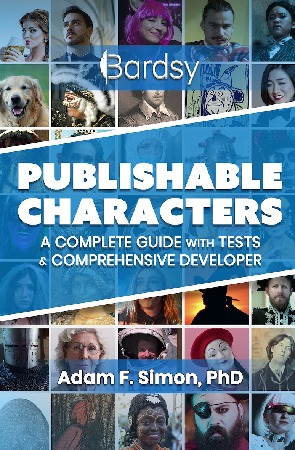😃 Subscribe for Weekly Posts:


Why do some characters jump off the page while others fall flat? The answer isn't luck or talent. It's understanding how fictional beings take shape in the reader's mind.
Spoiler alert: well-constructed fictional characters take shape just like real people! You, like every author, should know that creating characters that feel real is both a careful art and a precise science. Constructing beings that readers can instantly recognize, empathize with, and remember long after the story ends is no easy feat. Bardsy's Character Equation supplies one answer. Again, Our freshly published guide Publishable Characters: A Complete Guide With Tests & Comprehensive Developer presents this thinking in full.
In our last four blogs, we explored the three parts of the Character Equation and how to blend them into one believable character. This week, we put it all together with a detailed example. Let's break it down with your new friend, Pat.
First ingredient: Parts of You.
Whether you mean to or not, every character you write contains pieces of you. It may be your sense of humor, your stubbornness, or your affinity for dogs. This is called author self-donation. And though it often occurs organically, it's best to be intentional about it. Select specific aspects of your personality to embed into your beings—values, fears, quirks, or habits. You already have a solid foundation for your character!
Second ingredient: Cultural Universals.
The next piece of the equation comes from your readers. Every person who reads your story brings their own cultural knowledge with them: stereotypes and archetypes. This may sound limiting, but it's actually a powerful storytelling tool when utilized correctly. When you intentionally use these cultural universals, readers form instant connections with your characters.
Third ingredient: Specific Referents.
Referents are real (or fictional) people you draw from when crafting a character. Maybe Pat's bravery comes from a close friend you admire. Or perhaps Pat's way with animals was borrowed from your favorite comic book superhero. Referents anchor your character in realistic human behavior.
Step 2: Blending
Once you've gathered your ingredients, it's time to blend. This is where characters stop being concepts and start becoming people.
Now the example! Let's introduce and construct your new friend Pat.
Say the name aloud. Pat. In speaking their name, what did your mind's eye see? You're probably imagining a generic human, following the pattern set by your baseline. Now, let's add the smallest detail: the Firefighter. With just one descriptor, you've added a helmet, a Dalmation, and a firetruck, depending on your firefighter notions. Without any extra detail, your mind begins to construct the full picture.
Writers can leverage these mental shortcuts to their advantage. With just a few keywords, you can create vivid impressions that readers elaborate on automatically. The key is to activate the right connotations and subvert them when it serves your story.
Let's return to our example and begin with sketching out the story. Pat's tale concerns firefighting and bravery. You can see how this accommodates the stereotype. Specifically, the story focuses on another kind of bravery; Pat's facing retirement. Of course, the standard bravery of running into burning buildings remains in the background, but now the outline makes Pat's age a contextually critical characteristic. So, Pat's 62. He's male and in pretty good shape, albeit stocky. Not a candidate for greatest story ever told, but this outline sets the stage for the equation's use. We even have a better mental picture of Pat with these added details!
Maybe Pat's snarky and has an affinity for dogs (these would be your personal traits you're embedding). With this, we've narrowed the genre to comedy. Even better, Pat's getting a canine sidekick to support his role. (In case you're wondering, humans typically have simulacra for pets; they see them as people). Neither of these aspects should be hard to transplant.
Potential imports from stereotypes and archetypes begin with what firefighting could contribute. The theme also should heighten age's salience; being a boomer comes with loads of baggage!
Lastly, make him a grizzled warrior. Pat has been at war with fire for years; he's seen action and it shows. This archetype doesn't limit us, either; for example, maybe there's an enthusiasm about a new piece of technology. He dreams of setting up a high tech fire suppression system to score a decisive victory over his old foe. These choices, together, lead to more story, like minor character foils. Depending on who and what else enters the story, Pat's boomer warrior nature will manifest in different ways. Is he going to mentor a rookie? Perhaps he's injured and needs discipline to recover? Successful novels bring characters to life through plot.
Finding referents isn't too hard either, and they don't have to be boomers! Say Pat throws a temper tantrum. Who better to copy than a screaming child you've seen, as discussed above? Pat could work in NYC, or he could reside in the Appalachian wilderness. No matter what, he will be more authentic when your models match the relevant dimension. You could scour fiction for appropriate targets, too; however, the further you move from direct experience, the more wary you need to be.
Blending should begin ASAP. It will work because you have a simulacrum running. Remember, we blend through interaction! Talk to Pat, put him in situations and see how he responds. Open-ended questions are especially useful. Ask him about his day, his friends and his best war story. You're not creating backstory; you're integrating Pat through knowing him. It helps for these interactions to be creative, stressful and varied. Have him walk his dog. And not a vague, 'here's a leash, let's go.' Imagine a specific situation with a real dog. Where do they walk and how? Who do they meet? Imagination is an author's omnitool; here's the opportunity to use yours. In and outside of your writing, you'll come to know your character. Time and effort start a feedback loop that keeps enriching your mind's simulacrum as well as your page's words. By the time you're ready to polish your manuscript, you'll know your character better than your best friend and maybe better than yourself.
Remember Pat
So much goes into building a believable character. When all the elements of the Character Equation click into place, your creation gains the illusion of beingness. They move, speak, and feel like independent entities. You'll start hearing their voice in your head, noticing their habits, even missing them when the story ends.
So next time you sit down to write, think of Pat the Firefighter. Start with a name, a role, and a spark of personality. Let your readers' minds do some of the heavy lifting, and use your own experiences to keep things grounded. Blend, question, and explore until Pat becomes someone who could walk right off the page.
We will be looking at Bardsy Minimum Complete Story for the next few blogs, to get you ready for our 11/15/25 workshop. When we return to characters, probably after Thanksgiving, we'll explain how to add relevant details to Pat and others with our Comprehensive Character Developer. Quick plug: it produces a downloadable character sheet pdf. And stay tuned for the next step in this two part process: blending.